If you have driven down Peninsula Road recently you would hopefully have noticed the pink floral display on the “Erica field” at Rondevlei. These pink flowers are from Orphium frutescens (Teeringbos), whose flowers have waxy petals to allow them to flower later in the harsher conditions of summer. This allows them an advantage over many other plants which flower simultaneously in spring time.
We have all seen the spring time riot of colour when so many flowers are displaying; while this may look very pretty it creates a problem for a plant wanting pollination services. The problem is that insects at this time of the year are just spoilt for choice. A better strategy would be to flower later when you are the only show in town. This is what Orphium’s do and the mass floral display on the Erica field is a demonstration of this. Of course this strategy comes with its own challenges; any Capetonian knows that with summer comes the south-easterly winds. Strong winds create problems for plants, apart from drying things out it also blows pollen away; thus a plant flowering in the strong windy conditions of the Cape has to hold on to its pollen unless it wants it to end up in South America!
Orphiums are pollinated by the large, strong-flying carpenter bee (Xylocopa caffra) that can cope with the strong winds of the Cape. The Orphium plant protects its pollen by only releasing it in response to the buzz of the carpenter bees wings as it grabs the flower. This is called “buzz” or “sonic” pollination where a plant will only release pollen in response to a specific sound. If you look at the structure of the Orphium flower, you will noticed that the anthers (the pollen bearing part of the flower) are twisted. Pollen will not wipe off of them, instead pollen is only released from tiny holes at the top when they are vigorously shaken; which is something that only happens when a carpenter bee is on them.
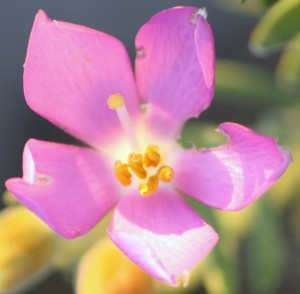
A close up of the Orphium flower. the tiny holes for the release of pollen can be seen at the tips of the anthers.
Look carefully and you will also see that the stigma (female part of the flower) is off to one side and faces upwards so as to pick up pollen when the carpenter bee lands on the flower. This prevents the plant being fertilised with its own pollen.
Yesterday I managed to capture the sequence of a carpenter visiting a flower, producing its vigorous buzz and leave with its prize of pollen. This is the sequence below:
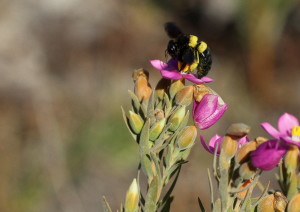
The carpenter bee lands so as to clasp the filaments of the anthers, positioning itself over the center of the flower. When landing it inadvertently scrapes pollen off its underside onto the stigma (female part of the flower).
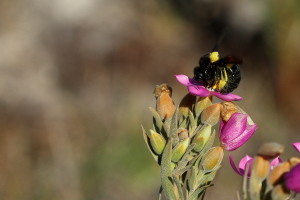
The carpenter bee tightly clasps the flower whilst emitting a audible “buzz” which shakes pollen from the twisted anthers.
Covered with pollen and its pollen sacks full, the bee flies off.
This is “buzz pollination” a remarkable display of how our plants and animals are supremely adapted to the remarkable part of the world that we live in. So the next time you are dashing out of the vlei, spare a thought for this remarkable drama going on right here at the side of Peninsula road where the carpenter bees sing to their flowers who in response give up their pollen.

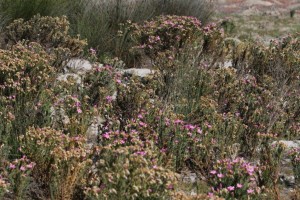
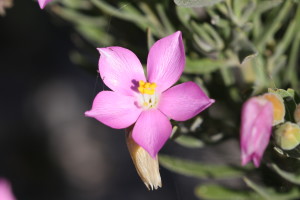
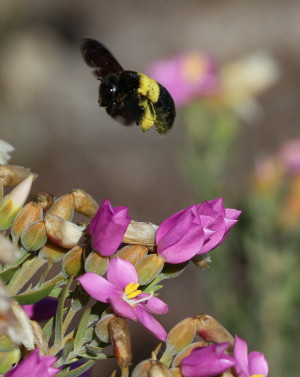
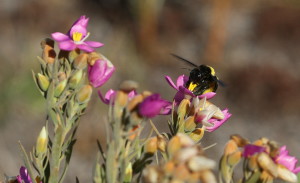
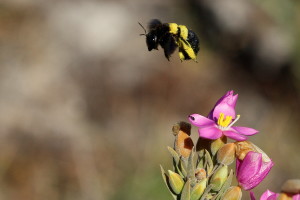
Wonderfully described and photographed
. Thank you!
I agree Charlene, thank you for this
Facinating! Thank you Dalton. Great pictures.
Very interesting, love the pictures too
Lovely pictures Dalton- during recent hikes on the mountain I am really surprised at the great many flowers in bloom this time of the year with the present dry climate.
Thanks, Dalton.
Lovely to see the details as photographed along with all the information.
I have carpenter bees in the garden. Will have to take time o watch and listen.
Hi Diana
The carpenter bees only do this with Orphium frutescens. The do shake other flowers when landing on them, but it doesn’t have the same effect as in Orphium plants. If you have Orphiums listen for the loud distinctive flat-toned buzz that happens when they alight on to a flower.